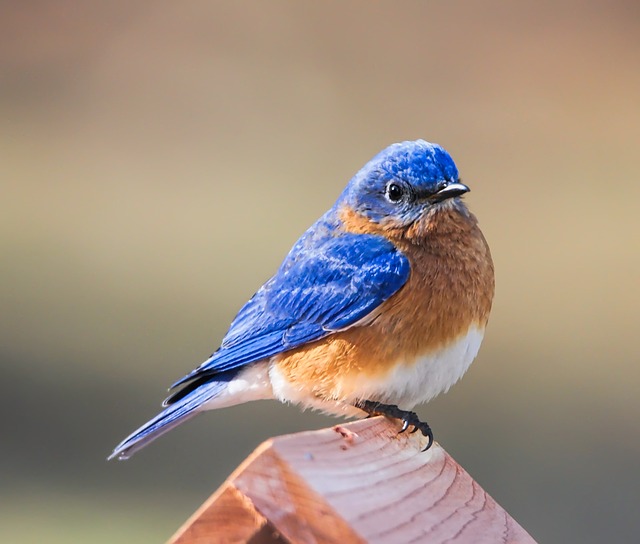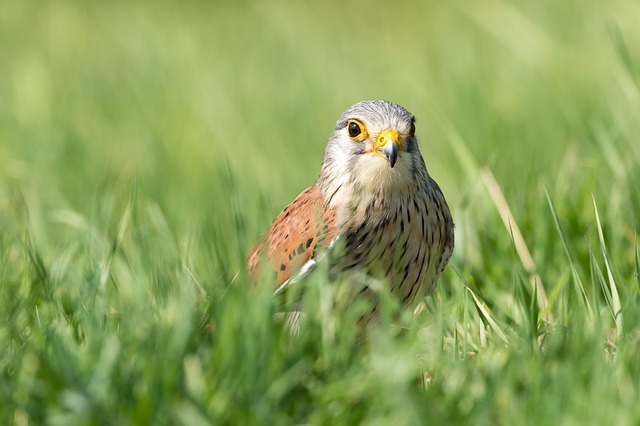Kansas is home to a variety of unique colored birds, ranging from purple, green, yellow, red and even a mixture of all the above. In this article I’ll simply be covering 7 unique orange birds, that consider the state of Kansas home.
- Baltimore Oriole
- Orchard Oriole
- American Robin
- Eastern Bluebird
- Cooper’s Hawk
- Barn Swallow
- American Kestrel
7 Orange Birds In Kansas
1. Baltimore Oriole (Icterus Galbula)

- Size: 15 – 20cm
- Weight: 38 – 43 grams
- Wingspan: 23 – 30cm
You’ll find baltimore orioles in most of Kansas throughout breeding season, although further west of the state they will only be making their migratory passage as opposed to remaining there.
Baltimore orioles are recognised by their orange/yellow, black and white plumage, where their head and wings are black in color, their breast and underside of the tail orange/yellow, with a beak that’s black in color. Females are very similar in color besides their head which isn’t black like the males.
Baltimore orioles can be found living around open deciduous woodlands where they will build their nests within American elms, cottonwoods, and maples.
In regards to what these orange and black birds feed on, it includes a variety of small insects like ants, wasps, beetles, grasshoppers, flies among others, flower nectar and smaller fruits like berries. They also feed on sugar water found within feeders.
A baltimore oriole can have a lifespan of around 11 years in wild.
2. Orchard Oriole (Icterus Spurious)

- Size: 15 – 18cm
- Weight: 16 – 28 grams
- Wingspan: 23 – 27cm
You’ll often find orchard orioles within the state of Kansas when breeding. The months when they tend to breed would typically cover the spring and summer months.
Orchard orioles tend have an orange breast and belly with their neck, head and a back black in color. Females are almost completely yellow with elements of of gray throughout their body.
They will often be located around semi-open habitats with deciduous trees and open space, including riverside trees, orchards, suburbs, forest edges, forest clearings and prairie groves.
Orchard orioles also eat a bunch of different food sources such as insects, nectar from flowers, sugar water from feeders and a number of other smaller berries and fruits.
Orchard orioles tend to live for around 11 years in the wild.
3. American Robin (Turdus Migratorius)

- Size: 12.5 – 14cm
- Weight: 16 – 22 grams
- Wingspan: 20 – 22cm
You’ll be able to spot American robins in the state of Kansas all year round.
These robins are recognised by their gray wings, back and tail, black head, yellow beak and orange belly/breast. Females have a far duller color scheme where the plumage that is black is mostly gray whilst the breast is a lighter orange tint.
American robins are often seen around woodlands, suburban backyards, parks, and grasslands with shrubs.
As for what they eat, it includes fruits, seeds, suet, crushed peanuts, sunflower hearts, raisins and a variety of insects like beetles, flies, worms, etc.
American robins have a lifespans of around 2 years on average, though some have been known to live up to 5 or 6 years.
4. Eastern Bluebird (Sialia Sialis)

- Size: 16 – 21cm
- Weight: 27 – 34 grams
- Wingspan: 25 – 33cm
Eastern bluebirds are year round residents in the southeast region of the state, whilst everywhere bar the western part of the state these bluebirds will stay in the state throughout the spring and summer breeding months.
These bluebirds are recognised by their blue back and upper head, their rusty orange neck and breast, with the belly a white color. Females on the other hand have all the blue parts of the plumage replaced by a darker gray color.
You’ll often eastern bluebirds around open country around trees, with little understory and sparse ground cover. This could also include habitats like frequently burned pine savannas, beaver ponds, mature but open woods, and forest openings.
Eastern bluebirds normally consume a variety of smaller insects, suet, smaller fruits and a variety of berries.
As for how long eastern bluebirds live for, it tends to be around the 6 – 10 year range.
5. Cooper’s Hawk (Accipiter Cooperii)

- Size: 35 – 51cm
- Weight: 400 – 700 grams
- Wingspan: 73 – 94cm
You’ll be able to find these hawks in Kansas all throughout the year as it’s a permanent residence of theirs.
Cooper’s hawks are recognised by their gray back and upper head with a orange and white patterned breast, legs and underside of the wing. The females and males look very much the same but, the females are around 30% larger than the opposite gender.
You’ll often find a cooper’s hawk around pines, oaks, Douglas-firs, beeches, spruces, and other tree species, often on flat ground rather than hillsides, and in dense woods.
As for what they eat, it includes mainly medium-sized birds including robins, jays, flickers, among other smaller and even larger birds. Small mammals like chipmunks, tree squirrels, ground squirrels, mice, bats, etc. are included in their diet too.
Cooper’s hawks tend to live for around 10 – 12 years on average whilst the oldest recorded hawk surpassed the 20 year mark.
6. Barn Swallow (Hirundo Rustica)

- Size: 17 – 20cm
- Weight: 17 – 21 grams
- Wingspan: 33 – 36cm
Barn Swallow are only spring and summer breeding residents within the state of Kansas.
Barn swallows are recognised by their dark blue, white and rusty orange plumage with the back a dark blue color with the breast and neck rusty orange in color. Females look very similar to the males but their breast plumage is white as opposed to rusty orange like the males.
These avians spend the majority of their time in farmlands or open pastures near water where they’ll occasionally build their mud and straw nests on ledges, generally on farm buildings.
Barn swallows mostly consume seeds, insects, fruits and a variety of berries.
These swallows tend to live for around 2 years on average, with the upper end of their lifespan being roughly 11 years.
7. American Kestrel (Falco Sparverius)

- Size: 20 – 24cm
- Weight: 115 – 125 grams
- Wingspan: 50 – 60cm
You’ll be able to spot American kestrels all throughout Kansas year round as it’s a permanent residence of theirs.
American kestrels are recognised by their spotted orange, gray, black and white plumage with their back orange with a black horizontal pattern, their wings a gray color, black tail feathers and orange sides with a gray and white head that has 2 black lines drawn vertically near both eyes. Females are mostly light brown.
American kestrels can be found in a variety of open or semi-open habitats from forest clearings, farmland and deserts.
As for what they eat, it includes small mammals such as woodmice and shrews, small birds, insects, earthworms with voles being their go to food source.
Wild Ameican kestrels are known to live for around 5 years but, captive variants have been known to hit 17+ years.
Amhil Khan, a dedicated nature enthusiast and the founder of BirdsOfTheWild.com, is a passionate advocate for the captivating world of avian wonders. With a deep-seated curiosity about the intricate lives of birds, Amhil’s journey began as a fascination and has evolved into a mission to inspire others to appreciate and protect these magnificent creatures.
Amhil’s love for birds led to the creation of Birds of the Wild, a platform where his expertise in ornithology, coupled with his captivating storytelling, provides readers with an immersive and educational experience. Through his lens and words, he captures the essence of birds in their natural habitats, offering a glimpse into their behaviors, migrations, and the ecosystems they inhabit.

